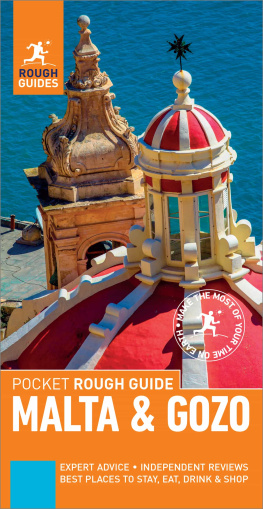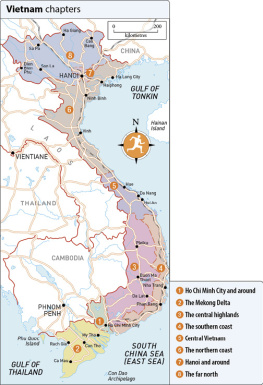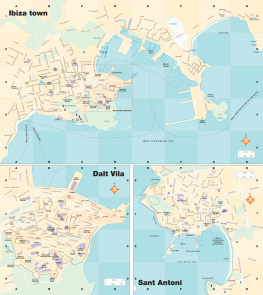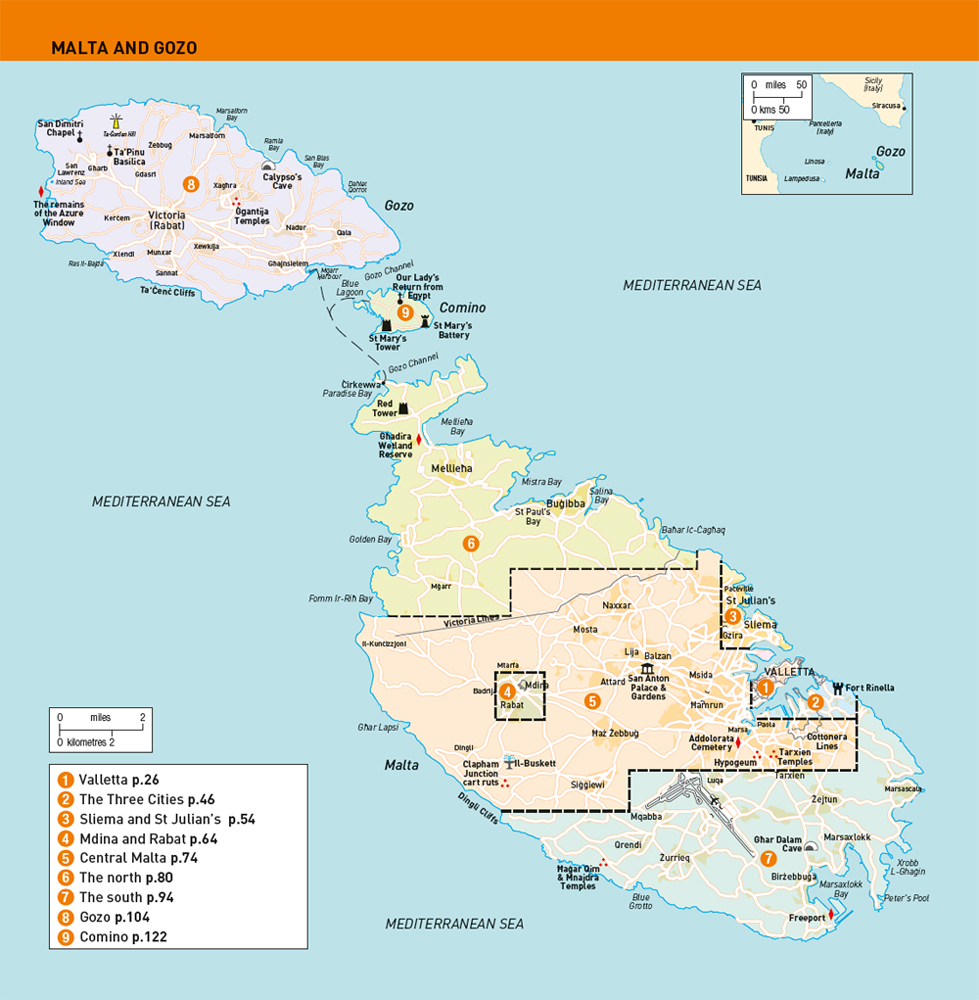CONTENTS
MALTA
Has any other tiny archipelago contributed so much to the history books? What sets Malta apart from other island destinations is the sheer number of historic sites, cultural attractions and ancient monuments squeezed onto its 246 square kilometres. With a dizzying number of World Heritage Sights for its size inescapable reminders of its complicated 7,000-year-old-history Malta feels like a huge open-air museum. But that doesnt mean its stuck in the past; in recent years Malta has truly come into its own as an alluring, quirky and rewarding destination. An abundance of top-notch restaurants, charming villages, brightly painted balconies, bustling promenades, vintage cars and warm hospitality means this little island leaves a big impression.

The intricately decorated interior of St Johns Co-Cathedral
Getty Images
The majority of Maltas historical sights are concentrated in Valletta and the Three Cities, laid out around the Grand Harbour and marked by immense limestone walls. These impressive fortifications are a legacy of its complicated history, which has alternated between long spells of isolation and brief outbursts of momentousness during periods of conflict when Maltas strategic location at the centre of the Mediterranean gave it a significance disproportionate to its size. There are plenty of opportunities to get to grips with Maltas military past, with a host of impenetrable forts and several museums dedicated to the islands crucial role during World War II and the Great Siege of 1565, when the Order of the Knights of St John repelled a six month attack by invading Turks. The Grand Harbours fortifications enclose a host of extravagant churches and palaces, the legacy of the Knights, who ruled the island for the next three hundred years. While the Baroque designs of the Knights are ever-present, the Neolithic era made an equally significant mark on the islands. The magnificent outdoor and underground temples across Malta and Gozo are the oldest freestanding man-made structures in the world, pre-dating Egypts pyramids. Second to none, there are more major Neolithic complexes here than in the whole of the rest of Europe.

Statue of St Peter in front of the Rotunda
Picfair
When to visit
The most popular time to visit is in high season (MayOct). In July and August, when the Maltese also take their summer holidays, the island can feel suffocatingly hot and crowded, but its a lively time to visit, coinciding with plenty of festivals and annual village feasts. Rain is nearly unheard of between May and September, and the countryside is parched and dry. Scorching temperatures make sightseeing difficult during midday, but evenings bring relief and life to village squares and promenades well into the night. Things get quieter in the low season (OctMay), when the weather is mild, rain comes in intense but infrequent bursts, and the countryside is vividly green (though mosquitoes can be bothersome). The sea is too cold for swimming, but comfortable temperatures make sightseeing very pleasant. Outside of the high season, the best times to visit are the autumn or spring shoulder seasons. Festivals continue into the autumn and the sea remains balmy, while in the spring, the countryside is ablaze with wild flowers.

Terronne
Terronne
viewingmalta.com
A short boat-ride from Malta, Gozo has a more rural character than its sister island. What it lacks in the number of historic attractions of the mainland, it makes up for with tranquility, natural beauty and an amenable Mediterranean lifestyle. Hilly topography, ravishing coastal cliffs and striking salt pans offer marvellous walks, while the dive sites offshore are widely acknowledged as some of the best in the Mediterranean.
Though a small island it can take a while to travel on Maltas congested roads, even by bus (there are 6 cars for every 10 people on the archipelago). Maltas public transport system is modern and robust, servicing the entire country, including the sparsely populated countryside. Buses typically run from 5am to 11pm and cost 1.50 (winter) or 2 (summer) for a 2-hour pass. More economical and convenient is the Explore Card (39), which offers 7 days of unlimited public bus travel and 2 ferry trips between Valletta, Sliema and the Three Cities. Travelling by foot or ferry can often be a faster option, particularly around Sliema, St Julians and Valletta (be sure to make eye contact with drivers before crossing the road). Double-decker private hop-on hop-off bus tours are also a convenient for touring Maltas major attractions (20, 1-day pass). Renting a car will free independent travellers to stray off the beaten path, but is not for the faint of heart. Driving styles here are aggressive at best and chaotic at worst, with road rules inconsistently observed and road conditions quite poor in some areas. However, reasonable rental fees (from 20/day) make this an economic option for families and groups. Renting a motorbike or scooter offers a faster way to bypass traffic on congested roads, but again, can be perilous. Cycling is just beginning to gain popularity in Malta and with very few bicycle lanes and a hilly topography, casual cyclists will find it nearly impossible to travel on two wheels (especially under the scorching summer sun).
Where to
Shop
Undoubtedly, Maltas riches lie in its plethora of cultural attractions not its shops but there are a few gems to uncover amongst its monotonous selection of high street outlets and souvenir shacks. For your pick of handmade treasures head to Gozo, where artisan lace, reed baskets, leather goods and local delicacies are readily found throughout Victoria and the Ta Dbiei Crafts Village. On Malta, youll find a Mdina Glass shop in every major village; a sure bet for gorgeous glass creations. For fashionistas, Sliema and Valletta are the places to see and be seen, with shopping malls and a few boutiques from local designers.
OUR FAVOURITES: Souvenirs That -->.
Eat
Dining out is an essential part of Maltese social life; according to national statistics, Maltese families spend just as much at restaurants as they do on rent and utilities. Unsurprisingly then, Malta is home to an astonishing number of restaurants: about 2300 at last count! Sliema, St Julians and Valletta are brimming with mid-priced and upscale restaurants, mostly Mediterranean, Italian and Asian. Farther afield, local pizza, pasta and burger joints are reliable for cheap eats. A particular Maltese favourite is the huge, long and boozy Sunday lunch, served at almost every restaurant but particularly popular at sea or countryside outlets.
OUR FAVOURITES: -->.
Drink
The ratio of bars to churches in Malta is easily three to one impressive, when you consider the island is home to over 359 churches! Visit Valletta for atmospheric wine bars and elegant cocktail lounges (both often have live music), or Sliema for drinks with a view at its plentiful seaside kiosks. For a cheap pint in any village, the


















